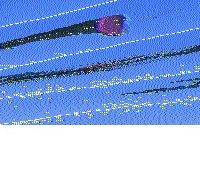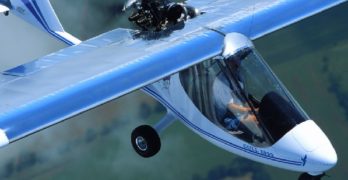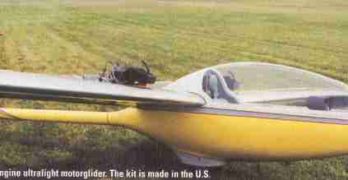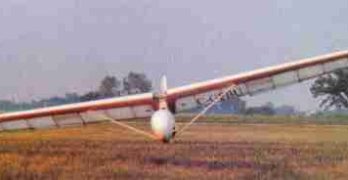In a calculated move planned for over a year, powered parachute leader Buckeye Industries introduced their new trike line at AirVenture ’98. This marks two points of interest to EXPERIMENTER readers.
The first point is a significant entry to the trike market, a segment of ultralight aircraft that has finally shown real growth potential after many years of effort by trike makers. Though European companies threw open the door with persistent marketing efforts mimicked by a few Yankee builders, Buckeye’s entry to the field could increase the number of trikes sold by a good margin.
Secondly, as a widely acknowledged sales leader among powered parachute builders, Buckeye is making something of a statement to that community of aviation enthusiasts. Powered parachutes deserve a follow-on aircraft and Buckeye has decided (logically, to my view) to make that successor a trike.
And, Why Not?
If you owned Buckeye and already made a slick, wheeled carriage for your powered parachutes, wouldn’t you also leverage that design to work for a trike?
Search Results for : CT AND hand control
Not finding exactly what you expected? Try our advanced search option.
Select a manufacturer to go straight to all our content about that manufacturer.
Select an aircraft model to go straight to all our content about that model.
Albatros
A dashing hybrid from the European microlight scene European microlight designers are blazing new runways to the sky.
Two decades after the first powered hang gliders were turned into powered ultralights, companies now offer two styles of aircraft. As one would expect, many ultralight designers have evolved their airplanes in new ways.
These producers now offer flying machines that employ the best ideas of familiar old designs (such as sewn Dacron wings and aluminum-tubing main structures), but they combine these tried and true components with composite fuselages and welded steel parts. Many variations on this theme keeps a wide range of aircraft in the pipeline.
Taking a different approach are those designers who are emerging from the world of kit-built designs. Some developers have conventional general aviation or airline design backgrounds. Whatever their experience, these engineers create clean-sheet designs that have evolved since the early days of aviation design.
As each tries to create a new microlight, they are not bound by any traditions, other than the laws of aerodynamics.
Built for two
After ten years of producing exclusively single seaters, Tennessee-based TEAM Aircraft broke with tradition and rolled out their very first two seater, the Tandem Air-Bike, at Sun ‘n Fun ’96, following the company’s successful Air-Bike design debuted two years earlier.
Wayne Ison’s TEAM got a lot of attention from the Air-Bike – it being regarded as an aircraft you get on, not in. That same sporty, fun-to-fly concept has now stretched into a two-seat model.
Some buyers will use the Airbike Tandem for instruction under the training exemption to Part 103. Others will N-number the machine and use it for the occasional joy ride with a passenger. It should work well either way. In fact, the close-quarters tandem seating means that when the aircraft is flown solo, it should perform well and yet feel more like the agile single seater than some other designs. This theory has worked well for Kolb and their Firefly II, for example.
Facing the buying decision
What Kind of Pilot Are You?
Let’s just say you actually know yourself. While this sounds like a comment that deserves a “duh!” response, don’t be too quick to judge. If every pilot or buyer of an aircraft knew what he/she needed or wanted, my job would be easier. But it isn’t so. Most pilots know something about what they want, but many don’t have enough information to make the best decision.
Some readers are “experts.” A good many ultralight or light plane enthusiasts have been around long enough and owned enough of a variety of ultralights to know what they like. These veteran sport aviators represent a lot of combined experience. If you’re new to ultralight flying, I strongly encourage you to seek out local experts. They can be your very best source of information because they know you. (However, as I reminded you last time, remember that anybody selling any aircraft – whether their own or one they represent – has a bias that you must not overlook.
Dakota Hawk
Vintage looks. A few companies in aviation specialize in the look and feel of aircraft from yesteryear. These manufacturers offer aircraft that are reminiscent of days gone by in aviation. Visually and even in the way they fly, these machines can transport enthusiasts back to the so-called Golden Era when the nascent aviation industry offered simple, easy to fly aircraft like the Piper Cub and others. Today, most of these specialty aircraft are kit-built airplanes because the freedom of the Experimental 51% rule permits exploration that cannot be justified when making a fully FAA certified model. Some of these kit manufacturers hail from the ultralight community. Fisher Flying Products is one such company.
Second-Generation Fisher
In two ways, North Dakota-based Fisher Flying Products is a second generation company. First, the company now owned by Darlene Jackson and husband Gene Hanson was purchased from Mike Fisher, who subsequently started another business using his name.
Gull flying in a new millenium
It is Mark’s design philosophy to make the most efficient aircraft he can, one that will use the least fuel. He defines himself as “a minimalist,” and this sentiment is carried throughout this beautifully optimized aircraft.
To me, Mark appears to have grown increasingly comfortable in his role within ultralight aviation. Relaxed and confident, he knows he has created a superior flying machine.
He also smiles a lot more these days in my opinion, thanks to a wonderful woman named Leslie who accompanied him to AirVenture 2000 in Oshkosh, Wisconsin. Married a year and a half ago, the two complement each other and make a good team.
No more tight squeezes
Perhaps it was this new personal relationship that motivated Mark to pay more attention to creature comforts. Notably, the Gull 2000 is wider than the previous single-seat or tandem two-seat Thunder Gull aircraft. Considering Mark is a lean and healthy vegetarian, his concern for broader pilots is no doubt appreciated.
Foxbat
Manta’s Foxbat is the original rigid-wing trike.
A few months ago here, I revealed what I believe will be a new trend among trike ultralights: the rigid-wing trike. This machine will take the increasingly popular trike concept into the 21st century by using a composite wing of very high aspect ratio. Such a wing brings increased performance and promises dramatically better handling than can be found on the so-called flex-wing trikes that presently do the heavy lifting on trikes.
Only time will tell if my prediction is right. Yet years-perhaps decades before these rigid wings become common, an Oakland, California, company produced a rigid wing trike of its own. Foxbat was the name. That it did not achieve great market success is no condemnation of the trike or its then-unorthodox wing.
In fact, Pterodactyl, which did achieve good sales, used this identical wing as its starting point for the company’s much more popular line of ultralights.
Esprit
Meet the Esprit – a twin-engine ultralight motorglider.
Soaring enthusiasts who want to self-launch their aircraft are limited to simple hang gliders on one end and expensive motorgliders on the other. Performance for these machines ranges 15:1 to 50:1. To get one you’ll spend $5000 or $200,000. What you could not do is spend $20,000 to get medium performance*… until now.
Debuting his machine at AirVenture 2000 airshow, Dobro Hajek brings a modern soaring aircraft to the ultralight community. I believe he will also find significant interest from two other groups: sailplane and hang glider pilots. Each loves dedicated machines without engines but many will also prefer an aircraft that can launch itself.
Welcome, Esprit
With its distinctive compound-tapered wings and winglets and its dual engines with folding props, the sleek Esprit goes a long way past the Aero Dovron that Hajek (pronounced HAY-yek) once imported. The Straton D-8 was an interesting little motorglider with a high wing and struts but at 17:1, this inexpensive machine didn’t have the go power it needed to attract a solid market in the United States.
Marske Sailplanes
The Marske Monarch continues to offer economical soaring.
Ultralight sailplanes. Are they a new category of aviation, a segment of ultralight aircraft or just little sailplanes? Though ultralights seem to be some of the newer aircraft in general aviation, their true lineage is based on soaring machines.
For example, the first and still most successful ultralights, the Quicksilver series, came from a hang glider design to which a small engine was added back in the 1970s. Trikes, which have continued to grow in worldwide popularity, are based on delta-wing hang gliders to which power and landing gear were added. Therefore, though the term may be relatively new (going back a decade or so), the aircraft has a longer heritage. One shining example of this is Jim Marske’s Monarch.
New Model, Old Design
Marske has been building the Monarch for 20 years and has added his higher performance model, the Pioneer, to his list of designs spanning 40 years.
- « Previous Page
- 1
- …
- 59
- 60
- 61







